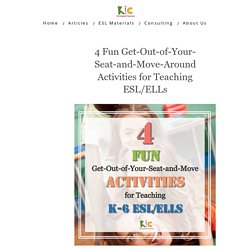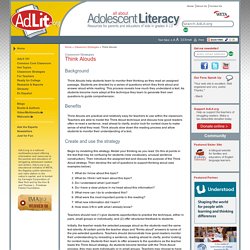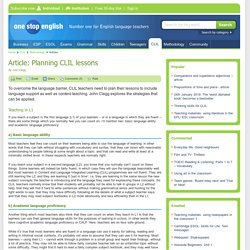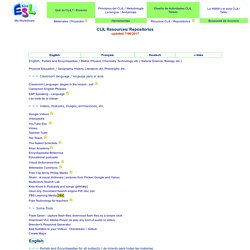

Feb 2019 - The What, Why and How of CLIL for English Teachers. 4 Get Out of Your Seat and Move Around Activities for Your ESL ELLs – Kid-Inspired Classroom. Scroll down if you want to get straight to the activities 🙂 As teachers, we have known this for a long time: Getting students out of their seats and moving around can be hugely helpful when it comes to learning in the classroom.

It can be easy to forget though and make it a secondary priority. “I should get through a certain amount of material first.” “I am just going to keep pressing on because we have so much to do.” We don’t really have time to get out of our seats for a move-around activity.” But then it gets more and more difficult to keep the students' attention, or keep them on task. I have to be stricter with them, and they get frustrated and lose interest more easily. The efficiency of the class goes down drastically. It takes me longer to get anything done with them because they are dragging their feet every step of the way.
They become like rusty old engines that haven’t been turned on in a while. For the next five minutes, they remember so much more of what they practice. 1. 2. 3. 4. Think Alouds. Classroom Strategies Background Think Alouds help students learn to monitor their thinking as they read an assigned passage.

Students are directed by a series of questions which they think about and answer aloud while reading. This process reveals how much they understand a text. As students become more adept at this technique they learn to generate their own questions to guide comprehension. Benefits Think Alouds are practical and relatively easy for teachers to use within the classroom. Create and use the strategy Begin by modeling this strategy. What do I know about this topic? Teachers should next (1) give students opportunities to practice the technique, either in pairs, small groups or individually; and (2) offer structured feedback to students. Initially, the teacher reads the selected passage aloud as the students read the same text silently. Further reading Davey, B. (1983).
Olshavsky, J. Wilhelm, J. Wilhelm, J. Student Fishbowl. Student Fishbowl This activity requires 60-90 minutes.

Purpose: Fishbowl activities force participants to listen actively to the experiences and perspectives of a specific group of people. A student fishbowl gives pre-service and in-service educators an opportunity to hear the experiences, ideas, and feedback of current students while giving the students an opportunity to be active in the dialogue on educational equity. Preparation: The only major resources needed for this activity are current K-12 students. To prepare for the actual fishbowl dialogue, ask the fishbowl students to sit in a circle in the middle of the room. Instructions: 6 Scaffolding Strategies to Use With Your Students. What’s the opposite of scaffolding a lesson? Saying to students, “Read this nine-page science article, write a detailed essay on the topic it explores, and turn it in by Wednesday.”
Yikes! No safety net, no parachute—they’re just left to their own devices. Let’s start by agreeing that scaffolding a lesson and differentiating instruction are two different things. Scaffolding is breaking up the learning into chunks and providing a tool, or structure, with each chunk. Simply put, scaffolding is what you do first with kids. Scaffolding and differentiation do have something in common, though. Reflections on CLIL: Lesson Reflection in CLIL. We can think of a CLIL lesson as a three course meal: an appetizer that energizes the learners at the start; the main course activities that hit all the key learning objectives for the lesson; and a final dessert that reflects on the lesson by consolidating what's been learnt.

It’s essential to plan for reflection at the end of a lesson in order to get feedback on the lesson — have the objectives for the lesson actually been achieved? For CLIL, wrapping up the lesson can be an opportunity to reflect on both the learning of subject content and also of language. It can also be an activity that provides another opportunity for learners to produce spoken output, sharing their ideas and reviewing their learning with each other. I often get asked by teachers for ideas for lesson reflectors. Here then are ten ideas for lesson reflectors in CLIL. Article: Planning CLIL lessons.
By John Clegg To overcome the language barrier, CLIL teachers need to plan their lessons to include language support as well as content teaching.

John Clegg explores the strategies that can be applied. Teaching in L1. Awesome Lesson Ideas to Integrate Science Across the Curriculum. CLIL Resources / Recursos AICLE. English: Portals and Encyclopedias / Maths, Physics, Chemistry, Technology, etc / Natural Science, Biology, etc / Physical Education / Geography, History, Literature, Art, Philosophy, etc.

Classroom language / lenguaje para el aula Classroom Language- stages in the lesson - pdf. Andamiaje (scaffolding) en CLIL / AICLE. Translating words into mathematics symbols. Chapter 13 - Games for Learning Science. Science Teaching Series Internet Resources I.

Developing Scientific Literacy. PlayingCLIL. PlayingCLIL handbook The playingCLIL eBook (full version), EN The handbook (short version), EN.

CLIL: A lesson framework. Underlying principlesClassroom principlesLesson frameworkConclusion Underlying principlesThe principles behind Content and Language Integrated Learning include global statements such as 'all teachers are teachers of language' (The Bullock Report - A Language for Life, 1975) to the wide-ranging advantages of cross-curricular bilingual teaching in statements from the Content and Language Integrated Project (CLIP).

The benefits of CLIL may be seen in terms of cultural awareness, internationalisation, language competence, preparation for both study and working life, and increased motivation. While CLIL may be the best-fit methodology for language teaching and learning in a multilingual Europe, the literature suggests that there remains a dearth of CLIL-type materials, and a lack of teacher training programmes to prepare both language and subject teachers for CLIL teaching. The theory may be solid, but questions remain about how theory translates into classroom practice. CLIL Projects and Materials (ready to be used) / Actividades y materiales CLIL - listos para usar /
Science facts and information for kids. Water Cycle and Water for Kids. Get Involved - Teaching. The One Moment - OK Go Sandbox. The One Moment - OK Go Sandbox.